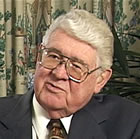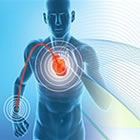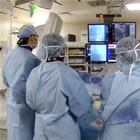
J. Willis Hurst, MD
(1920-2011)
Sad news out of Atlanta that Dr. J. Willis Hurst passed away on October 1 after a brief illness, a few weeks short of his 91st birthday. Hurst was a major figure in cardiology worldwide, having served as Professor and Chairman of the Department of Medicine at the Emory University School of Medicine for 30 years, and the author of “Hurst’s The Heart“, undisputedly the “bible” of cardiology, which is in its 13th edition and has been translated into more than five languages. It is considered to be the most widely used cardiology
textbook in the world. I know that every cardiologist’s office I’ve ever been in (and that’s a lot) has “Hurst’s The Heart” prominently displayed on the bookshelf. Continue reading

 Having an coronary angiogram or heart stent placed via the wrist approach is common in Europe. India and Japan — much less so in the U.S. — even though the wrist (transradial) approach offers lower complications and higher patient comfort. Some studies have even shown that the radial approach, with its significantly lower bleeding complications, is superior in treating heart attacks (STEMI) since those patients need to be on high levels of anticoagulation meds.
Having an coronary angiogram or heart stent placed via the wrist approach is common in Europe. India and Japan — much less so in the U.S. — even though the wrist (transradial) approach offers lower complications and higher patient comfort. Some studies have even shown that the radial approach, with its significantly lower bleeding complications, is superior in treating heart attacks (STEMI) since those patients need to be on high levels of anticoagulation meds. This weekend Richard R. Heuser, MD, FSCAI and John E. Lassetter, MD, FSCAI of St. Luke’s Hospital and Medical Center in Phoenix, Arizona will be conducting
This weekend Richard R. Heuser, MD, FSCAI and John E. Lassetter, MD, FSCAI of St. Luke’s Hospital and Medical Center in Phoenix, Arizona will be conducting  Dr. Paul Chan
Dr. Paul Chan  Dr. Ralph Brindis is the Immediate Past President of the American College of Cardiology and helmed the National Cardiovascular Data Registry (NCDR) since its inception in 1997 — this is the registry that was the source for the data analyzed and reported in yesterday’s JAMA study, “
Dr. Ralph Brindis is the Immediate Past President of the American College of Cardiology and helmed the National Cardiovascular Data Registry (NCDR) since its inception in 1997 — this is the registry that was the source for the data analyzed and reported in yesterday’s JAMA study, “ A major study of a half-million angioplasties, published today1 in the Journal of the American Medical Association (JAMA), refutes two major myths about angioplasty and stent use in the United States: myth #1, that angioplasty is vastly overused and unnecessary in most cases; and myth #2, that most angioplasty is used in stable patients and therefore has little or no benefit over drugs in reducing death or heart attacks.
A major study of a half-million angioplasties, published today1 in the Journal of the American Medical Association (JAMA), refutes two major myths about angioplasty and stent use in the United States: myth #1, that angioplasty is vastly overused and unnecessary in most cases; and myth #2, that most angioplasty is used in stable patients and therefore has little or no benefit over drugs in reducing death or heart attacks. “
“

